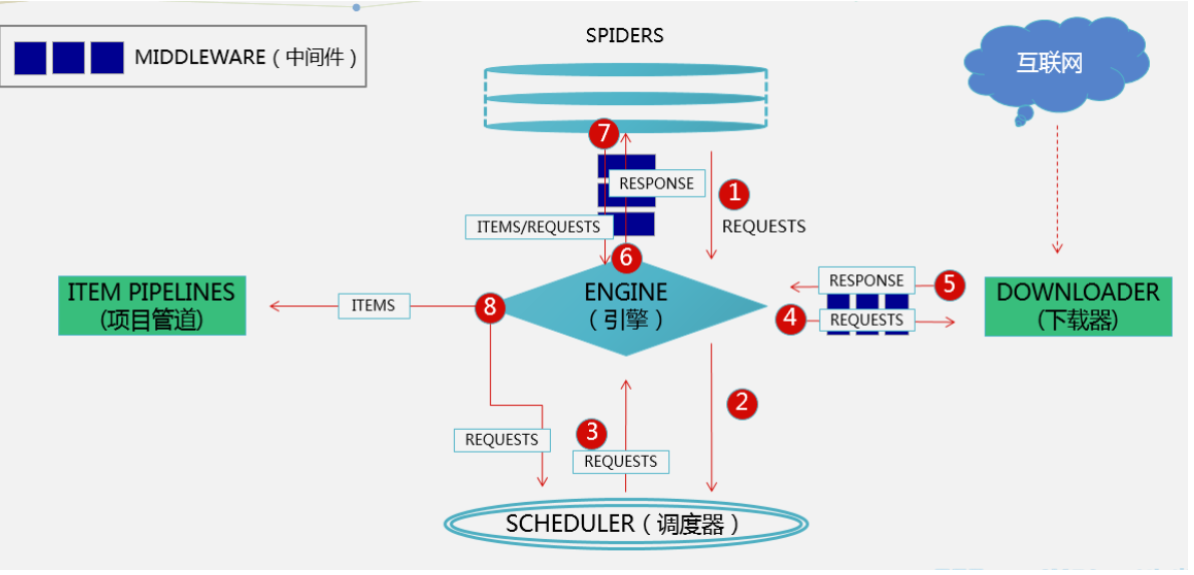目录
scrapy架构介绍

# 引擎(EGINE)
引擎负责控制系统所有组件之间的数据流,并在某些动作发生时触发事件。
# 调度器(SCHEDULER)
用来接受引擎发过来的请求, 压入队列中, 并在引擎再次请求的时候返回. 可以想像成一个URL的优先级队列, 由它来决定下一个要抓取的网址是什么, 同时去除重复的网址
# 下载器(DOWLOADER)
用于下载网页内容, 并将网页内容返回给EGINE,下载器是建立在twisted这个高效的异步模型上的
# 爬虫(SPIDERS)--->在这里写代码
SPIDERS是开发人员自定义的类,用来解析responses,并且提取items,或者发送新的请求
# 项目管道(ITEM PIPLINES)
在items被提取后负责处理它们,主要包括清理、验证、持久化(比如存到数据库)等操作
# 下载器中间件(Downloader Middlewares)
位于Scrapy引擎和下载器之间,主要用来处理从EGINE传到DOWLOADER的请求request,已经从DOWNLOADER传到EGINE的响应response,你可用该中间件做以下几件事:设置请求头,设置cookie,使用代理,集成selenium
# 爬虫中间件(Spider Middlewares)
位于EGINE和SPIDERS之间,主要工作是处理SPIDERS的输入(即responses)和输出(即requests)
scrapy的一些命令
安装完成后 会有scrapy的可执行文件
# 创建项目
scrapy startproject 项目名字 # 跟创建dajngo一样,pycharm能直接创建django
# 创建爬虫
scrapy genspider 名字 域名 # 创建爬虫类似django的创建app
eg:scrapy genspider baidu www.baidu.com
# pycharm打开scrapy的项目
运行爬虫
scrapy crawl 爬虫名字
想点击绿色箭头运行爬虫
新建一个run.py,写入,以后右键执行即可
from scrapy.cmdline import execute
execute(['scrapy','crawl','cnblogs','--nolog'])
补充:爬虫协议
http://www.cnblogs.com/robots.txt
scrapy项目目录结构
firstscrapy # 项目名
firstscrapy # 文件夹名字,核心代码,都在这里面
spiders # 爬虫的文件,里面有所有的爬虫
__init__.py
baidu.py # 百度爬虫
cnblogs.py # cnblogs爬虫
items.py # 有很多模型类---》以后存储的数据,都做成模型类的对象,等同于django的models.py
middlewares.py # 中间件:爬虫中间件,下载中间件都写在这里面
pipelines.py # 项目管道---》以后写持久化,都在这里面写
run.py # 自己写的,运行爬虫
settings.py # 配置文件 django的配置文件
scrapy.py # 项目上线用的,不需要关注
scrapy解析数据
1 response对象有css方法和xpath方法
css 中写css选择器
xpath中写xpath选择
2 重点1:
xpath取文本内容
'.//a[contains(@class,"link-title")]/text()'
xpath取属性
'.//a[contains(@class,"link-title")]/@href'
css取文本
'a.link-title::text'
css取属性
'img.image-scale::attr(src)'
3 重点2:
.extract_first() 取一个
.extract() 取所有
解析cnblogs
# 解析返回的数据
# 方式一 bs4 解析
# print(response.text)
# soup = BeautifulSoup(response.text,'lxml')
# 方式二: 自带的解析
# response.css()
# response.xpath()
# def parse(self, response):
# # 解析数据 css解析
# article_list = response.css('article.post-item')
# for article in article_list:
# title = article.css('div.post-item-text>a::text').extract_first()
# author_img = article.css('div.post-item-text img::attr(src)').extract_first()
# author_name = article.css('footer span::text').extract_first()
# desc_old = article.css('p.post-item-summary::text').extract()
# desc = desc_old[0].replace('\n', '').replace(' ', '')
# if not desc:
# desc = desc_old[1].replace('\n', '').replace(' ', '')
# url = article.css('div.post-item-text>a::attr(href)').extract_first()
# # # 文章真正的内容,没拿到,它不在这个页面中,它在下一个页面中
# print(title)
# print(author_img)
# print(author_name)
# print(desc)
# print(url)
def parse(self, response):
# 解析数据 xpath解析
article_list = response.xpath('//*[@id="post_list"]/article')
# article_list = response.xpath('//article[contains(@class,"post-item")]')
for article in article_list:
title = article.xpath('.//div/a/text()').extract_first()
author_img = article.xpath('.//div//img/@src').extract_first()
author_name = article.xpath('.//footer//span/text()').extract_first()
desc_old = article.xpath('.//p/text()').extract()
desc = desc_old[0].replace('\n', '').replace(' ', '')
if not desc:
desc = desc_old[1].replace('\n', '').replace(' ', '')
url = article.xpath('.//div/a/@href').extract_first()
# 文章真正的内容,没拿到,它不在这个页面中,它在下一个页面中
print(title)
print(author_img)
print(author_name)
print(desc)
print(url)
settings相关配置,提高爬取效率
scrapy 项目有项目自己的配置文件,还有内置的
基础的一些
# 1 了解
BOT_NAME = "firstscrapy" #项目名字,整个爬虫名字
# 2 爬虫存放位置 了解
SPIDER_MODULES = ["firstscrapy.spiders"]
NEWSPIDER_MODULE = "firstscrapy.spiders"
# 3 记住 是否遵循爬虫协议,一般都设为False
ROBOTSTXT_OBEY = False
# 4 记住
USER_AGENT = "firstscrapy (+http://www.yourdomain.com)"
# 5 记住 日志级别
LOG_LEVEL='ERROR'
# 6 记住 DEFAULT_REQUEST_HEADERS 默认请求头
DEFAULT_REQUEST_HEADERS = {
'Accept': 'text/html,application/xhtml+xml,application/xml;q=0.9,*/*;q=0.8',
'Accept-Language': 'en',
}
# 7 记住 SPIDER_MIDDLEWARES 爬虫中间件
SPIDER_MIDDLEWARES = {
'cnblogs.middlewares.CnblogsSpiderMiddleware': 543,
}
# 8 记住 DOWNLOADER_MIDDLEWARES 下载中间件
DOWNLOADER_MIDDLEWARES = {
'cnblogs.middlewares.CnblogsDownloaderMiddleware': 543,
}
# 9 记住 ITEM_PIPELINES 持久化配置 数值越小优先级越高
ITEM_PIPELINES = {
'cnblogs.pipelines.CnblogsPipeline': 300,
}
增加爬虫的爬取效率
# 1 增加并发:默认16
默认scrapy开启的并发线程为32个 可以适当进行增加,在settings配置文件中修改
CONCURRENT_REQUESTS = 100 值为100,并发设置成了为100。
# 2 降低日志级别:
在运行scrapy时,会有大量日志信息的输出,为了减少CPU的使用率。可以设置log输出信息为INFO和ERROR即可。在配置文件中编写
LOG_LEVEL = 'INFO'
# 3 禁止cookie:
如果不是真的需要cookie,则在scrapy爬取数据时可以禁止cookie从而减少CPU的使用率,提升爬取效率。在配置文件中编写:
COOKIES_ENABLED = False
# 4 禁止重试:
对失败的HTTP进行重新请求(重试)会减慢爬取速度,因此可以禁止重试。在配置文件中编写:
RETRY_ENABLED = False
# 5 减少下载超时:
如果对一个非常慢的链接进行爬取,减少下载超时可以让卡住的链接快速被放弃,从而提升效率,在配置文件中进行编写:
DOWNLOAD_TIMEOUT = 10 超时时间为10s
持久化方案
方式一:(parse必须有return值,必须是列表套字典形式---》使用命令,可以报错到json格式中,csv中(后缀 excel打开是表格)。。。)
执行
scrapy crawl cnblogs -o cnbogs.json
方式二:我们用的,使用pipline存储--》可以存到多个位置
第一步:在item.py中写一个类
class FirstscrapyItem(scrapy.Item):
title = scrapy.Field()
author_img = scrapy.Field()
author_name = scrapy.Field()
desc = scrapy.Field()
url = scrapy.Field()
# 博客文章内容,但是暂时没有
content = scrapy.Field()
第二步:在pipline.py 中写代码,写一个类:
class FirstscrapyFilePipeline:
def open_spider(self, spider):
print('我开了')
self.f = open('a.txt', 'w', encoding='utf-8')
def close_spider(self, spider):
print('我关了')
self.f.close()
def process_item(self, item, spider):
# item:是要报错的数据的对象
# print(item['title'])
# 把数据保存到文件中
self.f.write(item['title'] + '\n')
return item
第三步:配置文件配置
ITEM_PIPELINES = {
"firstscrapy.pipelines.FirstscrapyFilePipeline": 300, # 数字越小,优先级越高
}
第四步:在解析方法parse中yield item对象
以上是把爬取的数据插入到txt文件中
插入到数据库中 需要 mysqldb模块
1.提前建好数据库和表
在配置文件中添加以下字段 对应链接数据库
mysql_host='127.0.0.1' #地址
mysql_user='' #经过授权的用户名
mysql_passwd='' #经过授权的访问密码
mysql_db='' #数据库名称
mysql_tb='' #表名
mysql_port=3306 #端口,默认3306
配置文件中添加往数据库添加数据的配置如:
ITEM_PIPELINES = {
#数字越小优先级越高
#menu.pipelines.Class,Class与pipelines.py里的类名对应,如:menu.pipelines.MenusqlPipeline
'menu.pipelines.MenuPipeline': 300,
'menu.pipelines.MenusqlPipeline': 2, #提交到数据库
}
在pipline.py中添加以下的代码 保证链接数据库 和添加数据(中间字段和前面写的不一样 修改一致即可)
import MySQLdb
from .settings import mysql_host,mysql_db,mysql_user,mysql_passwd,mysql_port
class MenusqlPipeline(object):
def __init__(self):
host=mysql_host
user=mysql_user
passwd=mysql_passwd
port=mysql_port
db=mysql_db
self.connection=MySQLdb.connect(host,user,passwd,db,port,charset='utf8')
self.cursor=self.connection.cursor()
def process_item(self, item, spider):
sql = "insert into cookbook2(name,step,sugar,energy,fat,material1,needtime,img,level,material2) values(%s,%s,%s,%s,%s,%s,%s,%s,%s,%s)"
#注意 params添加的顺序要和sql语句插入的顺序一致,否则会出现错位甚至插入失败的情况
params=list()
params.append(item['name'])
params.append(item['step'])
params.append(item['sugar'])
params.append(item['energy'])
params.append(item['fat'])
params.append(item['material1'])
params.append(item['needtime'])
params.append(item['material2'])
params.append(item['img'])
params.append(item['level'])
self.cursor.execute(sql,tuple(params))
self.connection.commit()
return item
def __del__(self):
self.cursor.close()
self.connection.close()
启动爬虫,查看数据库数据插入是否正常
https://blog.csdn.net/L_Shaker/article/details/118891300 该博客可以借鉴
全站爬取cnblogs文章
request和response对象传递参数 解析下一页并继续爬取
def parse(self, response):
# 解析数据 xpath解析
article_list = response.xpath('//*[@id="post_list"]/article')
# article_list = response.xpath('//article[contains(@class,"post-item")]')
# l=[]
for article in article_list:
item = FirstscrapyItem()
title = article.xpath('.//div/a/text()').extract_first()
item['title'] = title
author_img = article.xpath('.//div//img/@src').extract_first()
item['author_img'] = author_img
author_name = article.xpath('.//footer//span/text()').extract_first()
item['author_name'] = author_name
desc_old = article.xpath('.//p/text()').extract()
desc = desc_old[0].replace('\n', '').replace(' ', '')
if not desc:
desc = desc_old[1].replace('\n', '').replace(' ', '')
item['desc'] = desc
url = article.xpath('.//div/a/@href').extract_first()
item['url'] = url
# yield item
# print(title)
yield Request(url=url, callback=self.parser_detail,meta={'item':item}) # 爬完后的执行的解析方法
next = 'https://www.cnblogs.com' + response.css('div.pager>a:last-child::attr(href)').extract_first()
print(next) # 继续爬取
yield Request(url=next, callback=self.parse)
def parser_detail(self, response):
# print(response.status)
# 解析出文章内容
content = response.css('#cnblogs_post_body').extract_first()
# print(str(content))
# 怎么放到item中
item = response.meta.get('item')
if content:
item['content'] = content
else:
item['content'] = '没查到'
yield item